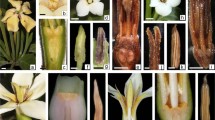Summary
In the dioecious plant Asparagus officinalis L. the female plants bear flowers that are all strictly of the same type, with well-developed pistils and collapsed and consistently sterile rudiments of anthers, while male plants, on the contrary, show a great variety of vestigial female organs, from small, rudimentary ovaries with no style and stigma, up to pistils provided with a rather long style that is often enlarged in a stigma. In our investigations, we used homozygous male and female doubled haploid plants obtained from in vitro anther culture, the all-male F1 progeny and male individuals from subsequent backcrosses. The results showed that: (1) the character “length of the style” is genetically inherited and involves at least two genes, the influence of the environment being quite negligible; (2) in male pistils provided with style and stigmatic papillae, the pollination and growth of the pollen tubes up to the ovules do actually occur as a rule, the only barrier to fertilization being the absence of normal embryo sacs inside the ovules; (3) the character “length of the style” is a very reliable marker of the trend towards hermaphroditism in Asparagus, since a correlation always exist between length of the style, size of the ovary, tendency to self-pollination, vascularization and rate of development of the ovules inside the male ovaries. On the whole, most of our observations, together with the high inbreeding depression observed when occasional andromonoecious plants are selfed, are consistent with the hypothesis of the origin of dioecy in Asparagus from hermaphroditism via the gynodioecy pathway.
Similar content being viewed by others
References
Bawa KS (1980) Evolution of dioecy in flowering plants. Annu Rev Ecol Syst 11:15–39
Bracale M, Galli MG, Falavigna A, Soave C (1990) Sexual differentiation in Asparagus officinalis L. II. Total and newly synthesized proteins in male and female flowers. Sex Plant Reprod 3:23–30
Charlesworth B, Charlesworth D (1978) A model for the evolution of dioecy and gynodioecy. Am Nat 112:975–997
Darwin C (1877) The different forms of flowers on plants of the same species. John Murray, London
Falavigna A, Casali PE, Tacconi MG (1990) Potential of in vitro anther culture. Technique for asparagus breeding in Italy. Acta Hortic 271:39–46
Franken AA (1970) Sex characteristic and inheritance of sex in asparagus (Asparagus officinalis L.). Euphytica 19:277–287
Herr JH (1971) A new clearing-squash technique for the study of ovule development in angiosperms. Am J Bot 58:785–790
Heslop-Harrison J (1957) The experimental modification of sex expression in flowering plants. Biol Rev 32:38–90
Heslop-Harrison J (1972) Sexuality of angiosperms. In: Steward FO (ed) Plant physiology. A treatise. Academic Press, New York, pp 133–289
Kalin Arroyo MT, Raven PH (1975) The evolution of subdioecy in morphologically gynodioecious species of Fuchsia sect. Encliandra (Onagraceae). Evolution 29:500–511
Kohn JR (1988) Why be female? Nature 335:431–433
Lazarte JE, Palser BF (1979) Morphology, vascular anatomy and embryology in pistillate and staminate flowers of Asparagus officinalis. Am J Bot 66:753–764
Lewis D (1942) The evolution of sex in flowering plants. Biol Rev 17:123–134
Lloyd DG (1980) The distribution of gender in four angiosperm species illustrating two evolutionary pathway to dioecy. Evolution 34:123–134
Loptien H (1979) Identification of the sex chromosome pair in asparagus (Asparagus officinalis L.) Z Pflanzenzucht 82:162–173
McNeilage MA (1991) Gender variation in Actinidia deliciosa, the kiwi fruit. Sex Plant Reprod 4:267–273
McNeilage MA (1991) Sex expression in fruiting male plants of kiwi fruit. Sex Plant Reprod 4:274–278
Mollenhauer HH (1964) Plastic embedding mixtures for use in electron microscope. Stain Technol 39:111–114
Qiao YM, Falavigna A (1990) An improved in vitro anther culture method for obtaining doubled-haploid clones of asparagus. Acta Hortic 271:145–150
Ross MD (1978) The evolution of gynodioecy and subdioecy. Evolution 32:174–188
Webb CJ (1979) Breeding systems and the evolution of dioecy in New Zealand. Evolution 33:662–673
Westergaard M (1958) The mechanism of sex determination in dioecious flowering plants. Adv Genet 9:217–281
Author information
Authors and Affiliations
Rights and permissions
About this article
Cite this article
Galli, M.G., Bracale1, M., Falavigna, A. et al. Different kinds of male flowers in the dioecious plant Asparagus of officinalis L.. Sexual Plant Reprod 6, 16–21 (1993). https://doi.org/10.1007/BF00227578
Issue Date:
DOI: https://doi.org/10.1007/BF00227578




